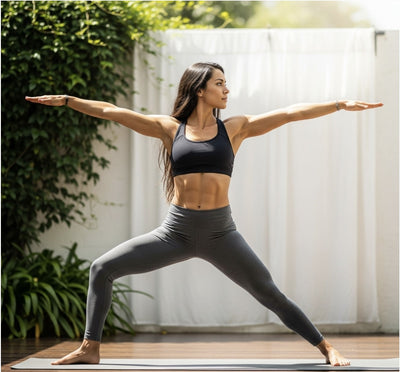
Mudras and Bandhas in Hatha Yoga: Meaning and Practice - 5To9Style
Share
Mudras and Bandhas in Hatha Yoga: Meaning and Practice
Introduction
Beyond the physical postures (asanas) and breathing techniques (pranayama), Hatha Yoga offers profound tools for influencing the body's subtle energy system. Mudras (symbolic gestures) and Bandhas (energetic locks) are ancient practices designed to direct and contain prana (life force energy) within the body, leading to deeper states of awareness and well-being. While they may seem esoteric at first, incorporating these techniques can significantly enhance your yoga practice and bring about powerful internal shifts. This article will demystify Mudras and Bandhas, explaining their meaning, common practices, and how they contribute to a holistic Hatha Yoga journey.
Understanding Mudras: Gestures of Energy
The word Mudra literally means "seal," "gesture," or "mark." In Hatha Yoga, mudras are precise hand gestures, body postures, or even eye movements that are believed to redirect energy flow and influence different areas of the brain and body. They act as "switches" to guide prana through specific energy channels (nadis), preventing energy from dissipating and enhancing the effects of asanas and pranayama.
Jnana Mudra / Gyan Mudra (Gesture of Wisdom):
Practice: Touch the tip of your index finger to the tip of your thumb, keeping the other three fingers extended. Place your hands on your knees, palms facing down.
Meaning & Benefits: This is one of the most common mudras, often used during meditation. It represents knowledge and wisdom, enhancing concentration, calming the mind, and reducing mental tension. It's believed to connect the individual self with the universal self.

Dhyana Mudra (Gesture of Meditation):
Practice: Place your right hand on top of your left hand, palms facing up, with the tips of your thumbs gently touching. Rest your hands in your lap.
Meaning & Benefits: Often seen in images of the Buddha, this mudra is ideal for deep meditation. It fosters concentration, brings inner peace, and promotes equanimity by creating a circuit of energy for profound stillness.

Vayu Mudra (Gesture of Air):
Practice: Bend your index finger until its tip touches the base of your thumb. Press your thumb gently over your index finger, keeping the other three fingers extended.
Meaning & Benefits: Believed to balance the air element (Vayu) in the body. It can help alleviate issues related to excess air, such as gas, bloating, and joint pain, and calm an overactive mind.

Understanding Bandhas: Energetic Locks
Bandhas are internal energy locks or muscular contractions that are applied to specific areas of the body to redirect the flow of prana. They are powerful tools used in advanced Hatha Yoga and Pranayama practices to awaken energy, purify the internal system, and facilitate deeper meditative states. When engaged correctly, they create a subtle pressure that helps to lift and channel energy upwards along the central energy channel (Sushumna Nadi).
Mula Bandha (Root Lock):
Practice: A gentle contraction of the perineum (the area between the anus and genitals). It's a subtle lifting and engaging of the pelvic floor muscles, similar to holding back urine or gas.
Meaning & Benefits: The most fundamental bandha, Mula Bandha helps to ground energy, activate the root chakra, and prevent downward dissipation of prana. It can bring a sense of stability, focus, and can also strengthen pelvic floor muscles.
Uddiyana Bandha (Abdominal Lock / Upward Flying Lock):
Practice: After exhaling completely, pull the abdominal muscles sharply inward and upward, creating a hollow in the belly. This is typically done on an empty stomach and on the retention of the exhale (bahya kumbhaka).
Meaning & Benefits: Uddiyana Bandha stimulates digestion, strengthens abdominal muscles, massages internal organs, and lifts prana upwards. It's considered highly purifying and energizing.
Jalandhara Bandha (Throat Lock):
Practice: Lower your chin towards your chest, pressing it firmly into the jugular notch (the indentation just above the breastbone). This is often done during breath retention after inhalation (antara kumbhaka).
Meaning & Benefits: Jalandhara Bandha regulates the flow of prana to the head, neck, and heart. It helps to calm the mind, reduce stress, and can be used to control the flow of breath during pranayama practices, preventing energy leakage.
Maha Bandha (The Great Lock):
Practice: This involves engaging all three bandhas (Mula, Uddiyana, and Jalandhara) simultaneously, typically on the retention of the exhale.
Meaning & Benefits: Maha Bandha is considered a highly advanced and powerful practice, aiming to consolidate and direct prana throughout the entire body, leading to profound energetic shifts and meditative experiences.

Integrating Mudras and Bandhas into Your Practice
Mudras and Bandhas are subtle but powerful techniques that can be integrated into your existing Hatha Yoga or meditation practice.
Start Simple: Begin by practicing simple mudras during meditation or pranayama. For bandhas, start with gentle, isolated contractions of Mula Bandha before attempting Uddiyana or Jalandhara, and always learn from a qualified instructor.
Awareness is Key: The effectiveness of mudras and bandhas lies in mindful awareness. Pay attention to the subtle energetic shifts and sensations within your body as you practice.
Consistency: Like asanas and pranayama, consistent practice yields the most profound benefits. Even a few minutes of mindful mudra or bandha engagement daily can make a difference.
Listen to Your Body: Never force any mudra or bandha. If you feel any discomfort or pain, ease out of the practice.
Having the right yoga wear is also important for allowing your body to move and breathe freely, especially when engaging internal locks. Loose-fitting or stretchy yoga pants and breathable tops from 5to9 Style ensure that your clothing doesn't hinder your practice, allowing you to focus on the subtle energy work.

Elevate Your Practice with 5to9 Style
As you delve into the intricate world of Mudras and Bandhas in Hatha Yoga, 5to9 Style is here to support your journey. Our collection of yoga apparel is designed with the understanding that true comfort and flexibility are essential for these subtle practices. Our activewear ensures that your clothing moves with your body, allowing for unrestricted breath and energy flow, helping you to maintain focus on your internal work.
From breathable yoga tops to incredibly flexible yoga leggings, our fitness essentials are crafted to enhance your mindful practice. Explore our full range at https://5to9style.com/collections/all and discover the perfect yoga wear to support your exploration of these profound yogic techniques.
Conclusion
Mudras and Bandhas are powerful, yet often overlooked, components of Hatha Yoga. By incorporating these symbolic gestures and energetic locks into your practice, you can deepen your connection to prana, enhance concentration, and unlock new levels of physical and energetic well-being. Approaching them with patience, awareness, and guidance from a qualified instructor will allow you to experience their profound transformative effects. Embrace these subtle practices and elevate your yoga journey.
Ready to explore the deeper dimensions of yoga? Visit https://5to9style.com to find out more about 5to9 Style and browse our collection of premium yoga wear designed for your complete practice.








